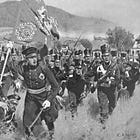This is the eighth post in a multi-part series. To find previous installments and those that follow, please consult the following guide.
From the time of the occupation of the shelter trenches on the village height by the enemy, our artillery had concentrated their fire on the enemy’s guns. These, however, were determined not to be drawn off from their proper work. I saw how they were shelling that edge of the wood which was nearest to them, and the brushwood on the bank of the brook in front of us, choosing those places which the 1st Regiment would have to cross.
‘They will have a hot reception on the other side of the brook’, I thought. ‘How will the close order stand it? Through the wood and dense brushwood, over the deep wooded-depression of the brook, and then into the shrapnel quick fire. This first trial of the close order tactics is a hard one—too hard, I think.’
I followed with great anxiety the movement of the firing line. It stepped forward cheerily and quickly till it reached the wood and brushwood. There the platoons opened out and divided in a variety of ways in order to pass quickly through the obstacles. They endeavored, as far as possible, to keep their places in lines, and not to increase the front.
I saw one platoon go through fairly open brushwood in single file. another formed fours deep, so that four men, one behind the other, followed the same path. Others moved through in files of sections or half platoons. More extended regularly and left it to each man to find the best way he could. All this happened without hesitation. The wooded ground was passed with great speed. Clearly they had been well trained for such country.
As I had foreseen, scarcely had the first detachments emerged into the open than the massed shrapnel fire of the enemy opened upon them.
‘Forward! Forward!” I shouted, in the greatest anxiety, ‘don’t go back into the wood! Don’t halt! Forward! The fire zone must be passed. Only a few hundred yards forward and the worst is over. The enemy is expending all his fire at this one range.’
But these brave troops thought otherwise. To hurry forward in confusion and be dispersed was evidently contrary to their education.’Close, close’, was heard on all side. ‘Close’, shouted the officers, holding up their swords for their platoons to rally on them. And amidst the deafening crash of the bursting shells, amidst the hailstorm of bullets and shell fragments, these little detachments endeavored to close their ranks, and to recover their order before doubling onward, out of the danger zone.
I felt ashamed. In the old dispersed order the officers in the firing line would have shouted as I did. ‘Forward’, and hurried on with the nearest men to them.
The other men, left to their fate, would most certainly have been unable to resist the magnetic attraction of the cover given by the wood, and have either stopped in it or hurried back into it. With the close orders tactics the leaders being responsible for the cohesion of their platoons, knew this duty better.
‘Should you all perish in this battle, victims of discipline and order’, shouted enthusiastically, ‘I will defend and admire you. He who finds fault with this knows not the source of success in war’.
To be continued …
Soon after an installment of this series appears in the pages of The Tactical Notebook, a link to it will appear on the following guide.






